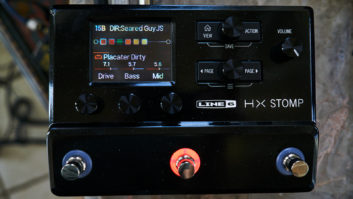A year ago, Fostex announced its DV40 Timecode Master Recorder, the first multichannel deck designed to record and play back audio data directly onto DVD-RAM discs. The three-rackspace DV40 could write up to four channels at 16- or 24-bit resolution in UDF format (Universal Disk Format), sampled at up to 192 kHz. At the time, Fostex also announced the development of a compact, portable companion deck for 6-channel location recording. Now, after months of research, development and field testing, Fostex will unveil its PD-6 DVD Recorder at this month’s AES in Los Angeles.
At first glance, the PD-6 resembles the venerable Fostex PD-4 location DAT recorder; in fact, it’s barely half an inch larger than the PD-4. But on closer examination, the PD-6 offers a lot more on the dash and under the hood. Besides its D25-sub multichannel AES/EBU digital I/O (with breakout cable to XLRs), six XLR analog inputs and six XLR analog outputs, USB and IEEE1394 FireWire outputs are standard for simplified connectivity to any DAW.
Under a top panel door lies the drive for double-sided, mini DVD-RAM discs — about twice the cost of a DAT tape, but offering far greater storage capacity, instant access and compatibility with DVD drives on the host PC. Speaking of compatibility, the PD-6’s recorded data in either SDII or BWF (Broadcast .WAV) is stored in two dedicated directories, allowing both file formats to co-exist on the same DVD-RAM disc. This offers full audio file disc compatibility and the ability to mount into any PC’s platform, regardless of the OS. Alternatively, files can be output directly from the PD-6 via its FireWire or USB ports.
Like the DV40, the PD-6 handles all timecode frame rates (30, 30DF, 29.97, 29.97DF, 25, 24 fps), as well as 0.1% pull-up/down at any rate and 23.97 fps for Sony HD cameras. Also standard are video sync/wordclock I/O on BNC jacks, LTC SMPTE/EBU timecode I/O on XLRs and a mini-Lemo 5-pin Aaton timecode port. The PD-6’s onboard timecode generator has a Jam function and four TC modes: 24H RUN (the generator runs in sync with the PD-6’s internal clock), REC RUN (TC only runs while the deck is Record mode to maintain continuity of takes), FREE RUN (TC generator runs independently of Operational mode) and EXT RUN (the PD-6 regenerates TC coming from an external source and records it).
The PD-6 was built from the ground-up with location recording in mind. A built-in Matrix function offers headphone monitoring of stereo signals, any mono channel or decoded MS microphone recordings. A small monitor speaker is located on the side of the case, and an onboard 1kHz slate tone generator has a variable output level. The recorder has three-way powering: industry-standard, NP-1B rechargeables; an AC adapter; or an external 12 to 24 VDC source (Cine-60 belts, Anton Bauers, Frezzis, etc.) via a 4-pin XLR power jack. Just below this main power XLR, Fostex includes two convenient mini-Lemo jacks, which output 12 VDC to feed two wireless receivers.
The degree of input control is comprehensive. Each of the six analog inputs can be switched from line or mic, with 12 or 48VDC phantom powering. Switches on each input can also select a variable (50 to 300Hz), -12dB/octave highpass filter and/or limiter with selectable hard/soft-knee characteristics. The 6-channel mixer has six discrete aux buses (with pre/post-fader switching), PFL on every channel and large, rotary-level controls.
Audio aside, perhaps the most innovative aspect of the PD-6 is its user interface. One major design criterion was to use as many “hard” controls as possible, reducing the need to constantly page through menus to find vital functions. Most of the PD-6 menus are based around saving/recalling operational setups, thus simplifying field use. A front panel data wheel (with push-to-enter functionality) and a prominent Exit key make navigating the unit’s few screens a breeze. The all-important Stop and Record keys are large and well-placed; another nice touch is a second smaller Stop key located on the top panel. One slick new feature is a Circled Take function, a button next to the front Stop key that automatically selects the designated take as the “keeper.” Yeah!
With the debut of the PD-6, Fostex has created a well-thought-out recording package offering high-resolution audio, low-cost/high-density media and a feature set designed for the serious location recordist. The PD-6 is said to be comparable to PD-4 pricing, and initial deliveries are slated to begin in December. For more information, visit www.fostexdvd.net.



